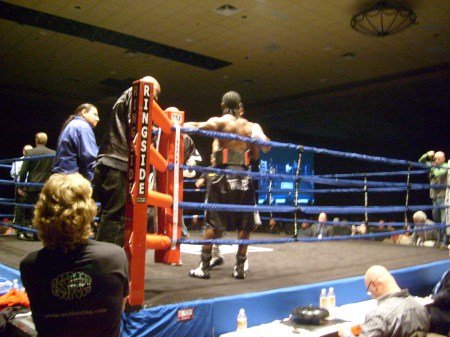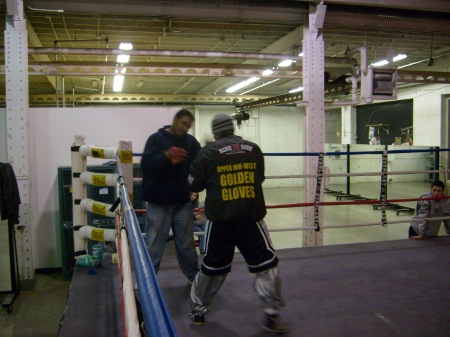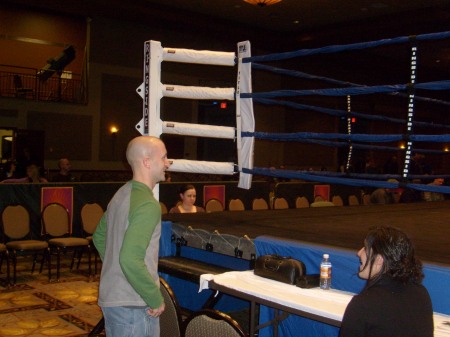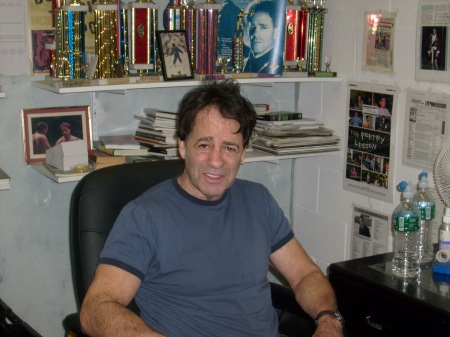by
Mark Connor
© Copyright 2009, Mark Connor
All athletes claim their sport to be the metaphor of life, but boxers seem to do so more legitimately, if only by virtue of the extra intensity of any misfortune that occurs. Such was the case with the “Out Cold” night at Grand Casino in Hinckley, Minnesota, Co-promoted by Seconds Out Promotions and Goosen Tutor promotions.
The card suffered a heavy blow when Shawn Estrada, who represented the United States in the Middleweight Division at the Beijing Olympics last summer, canceled due to a shoulder injury. There were a number of other cancellations and rearrangements of the card before the opening bell of the first fight, and the third straight weekend of below zero weather made the odds of a large crowd about as good as that of beating the house. Nevertheless, the 2,500 seat Grand Casino Hinckley Events and Convention Center nearly sold out, and the crowd’s energy combined with the overall talent in the ring to yield a very entertaining night.

Rayco Saunders in corner after what he thought was an upset over Marcus Oliveira © Copyright Mark Connor, 2009
The biggest surprise was how well the underdog in the main event, Rayco Saunders, 16-10, 7 KOs of Pittsburg, PA, fought in his Light Heavyweight contest against favorite Marcus Oliveira, 15-0, 12 KOs, of Lawrence, KS. While Oliveira seemed to live up to his reputation in the first and second rounds, Saunders made adjustments and outboxed him for the rest of the fight. The judges didn’t see it that way, though, giving Oliveira a majority decision of 78-75, 78-76, and 74-74. I spoke to Judge Denny Nelson afterwards, as well as Judge John Mariano. Nelson scored the fight for Oliveira, and Mariano had it a draw.
“You have to quit looking at women half the fight,” Nelson joked with me, saying I was mistaken in my assessment of the contest. Mariano told me he scored the fifth round on for Saunders, but Oliveira won the first four. It’s a lesson in how people view fights differently, and also in the position from which official judges witness it in contrast to the rest of us. There was a mix up between me and the promoters, so instead of getting a press pass I was granted entry that only afforded me the chance to sit just behind press row at ringside. That meant I was in the dark with the rest of the crowd looking into the lights over the ring, whereas the judges were underneath the lights, right up against the ring apron. But I still noticed a lot I can explain to you here, and I have to say Mariano’s final tally is a much more accurate judgment, at least in my humble opinion, than the others.

Saunders, left, fought a strategic fight, while Oliveira struggled to stay undefeated. © Copyright Mark Connor, 2009
Oliveira obviously won the first two rounds. In fact, Saunders was making a big mistake, leaning in and smothering himself against Oliveira’s body with his left hand down after throwing the jab. This not only took power and speed from Saunders, but it opened him up for right hands. Oliveira’s corner must have told him to throw the right in the second, because he did a few times effectively. But Saunders suddenly made a strategic adjustment that changed the fight for the rest of the night.
Saunders began moving to the right, and kept doing so in the third round. He used the jab and took control for the second half of the round, winning it on my card 10-9. That would have put him behind 29-28. In the fourth round Saunders mistakenly moved to his left and back into an effective right hand from Oliveira, but then readjusted, started moving away from that punch to the right more regularly, and boxed very effectively. At this point I believed the fight to be all even.

A mixup with the promoters saw me ringside by the red corner, not in press row. Could that cloud my "expert" judgment of the fight? © Copyright Mark Connor, 2009
In the fifth round Saunders out jabbed, outmaneuvered, and out punched Oliveira, and Oliveira was tired, backing up, and getting hit too much. In the sixth Oliveira was still tired, his mouth open, and backing up, and Saunders did the same things just as effectively. In the seventh Oliveira, still tired, did come forward but lost momentum, retreating from a hard body shot near the end of the round. Saunders dominated the round and answered Oliveira’s power evenly at the end. Oliveira did his best in the last round but it just didn’t seem enough in my eyes, and even the loudest, most obnoxious drunk in the crowd drew approval from those around him when poignantly yelling to Oliveira, “Come on—you need a knockout!” Evidently he didn’t, but when he fights someone in the top 100 of the Light Heavyweight division, he must perform better.
Even though I disagreed with that decision, as did Saunders and his corner and much of the crowd, the fight and the card itself were of the highest quality.
The best raw talent of the night was displayed by Wilshaun Boxley of Anoka Coon Rapids. A fighter who learned the trade at the Circle of Discipline in South Minneapolis, where he became one of the top amateurs in the United States, he now shows the potential to become a world class professional.

Wilshaun Boxley, right, displayed the most raw talent of the night when in only his fourth professional fight he outboxed skillful veteran Torrence Daniels. © Copyright Mark Connor, 2009
While Boxley’s opponent at the 122 pound division, Torrence Daniels, has only defeated opponents whose win-loss averages are 500 or worse, his losses are primarily against undefeated fighters. Entering the ring with a record of 12-7, 5 K0s, he has one draw and was knocked out one time, by Bernabe Concepcion, whose record was 24-1-1. Although he’d lost his last three fights, the 34-year-old went the distance in all of them, the last two being 8 round fights, and the previous one 6. Such a fighter is a perfect match for a talented man like Boxley, who’s obviously not content with fighting lay down opponents, and it’s even more impressive that he had a 6 round fight in only his fourth time out.

Boxley, foreground, outboxed Daniels for six rounds, but the veteran was too skillful to be taken out. It was a good learning experience for this point of Boxley's career. © Copyright Mark Connor, 2009
Boxley, now 4-0, 2 KOs, took control from the beginning. My assessment of the fight agreed with Denny Nelson’s tally of 59-55 for Boxley. Although he out jabbed the taller man and outmaneuvered him round after round, Daniels showed himself to be highly skillful and competitive, and he obviously knew he could go the distance. A couple of times I thought Boxley should have tried harder to hurt him, and maybe even see if he could finish him off. Particularly in the last round, which I gave to Daniels, I thought Boxley laid back and took too much of a breather. Two things Daniels did very well but can’t be counted as reasons for giving him rounds are throwing low blows and landing a head butt. The low blows came effectively in the 4th round, and referee Mark Nelson didn’t motion for him to keep the punches up until Boxley stepped back and voiced complaint. Daniels threw low blows from an angle at which it was hard for the referee to see, but from where I was the view was clear. That’s the smart way to do it, and even though it’s not fair, it’s a means of survival a veteran sometimes learns to rely on against a younger, stronger man. He landed the head butt at the end of the 5th round. He did it so smoothly, taking a half step back from the middle of the ring, letting Boxley come charging in on him, crouching a little and motioning forward quickly so that the top of his head landed between Boxley’s eyes. Boxley stepped back and shook the cobwebs form his head, obviously disturbed. But alas, it only slowed him a bit and forced him to go the distance, which is a good learning experience for this point of his career.
Another exciting fight was the battle between Featherweights Wilton Hilario and Darrell Martin. Hilario came at the taller opponent from the beginning, the way he always does, winging wide lefts and rights nonstop. Martin’s only chance was to control the fight with a strong jab and keep it in the center of the ring, but instead of using his height and reach advantage, he chose to slug it out with the slugger. Hilario, entering the fight with a record of 9-0-1, 7 KOs, is solidly chiseled with strength and endurance, and his overwhelming attack proved too much for Martin, who entered with a losing record of 4-6, 1 KO, and was unable to answer the bell for the 6th round. He showed a lot of courage in battling that long, though, and while Martin sealed his fate by not using the physical tools available to him, Hilario made the fight much harder on himself than he had to.

Hilario, right, entertained the fans with his knockout victory, but he made the fight more difficult than it had to be. © Copyright Mark Connor, 2009
Wilton Hilario is a fighter I’ve been watching since 2005. He won the Upper Midwest Golden Gloves that year in the very same arena at Grand Casino, while Boxley, his Circle of Discipline teammate, won the Featherweight Championship. Hilario at that time used his defense much more effectively than he has in recent professional fights. I’ve watched him training at Uppercut Boxing Gym in Northeast Minneapolis since he turned professional under the Tutelage of Chuck and Pete Daszkiewicz and Jacques Davis. I had the opportunity to spar with him for two rounds in August, 2006, when he was 6-0, 6 KOs. Mind you, at that point I hadn’t competed in 12 years, but I could still make observations, and while I wish to acknowledge his determination, dedication and skills, I also feel compelled to point out the obvious problems he must correct for advancement in his career. First of all, he impressed me as a fearless warrior with overwhelming strength. Also, when he lands a shot, there’s always power behind it. It is worrisome, though, to see him come forward without regard to his safety. He’s terribly susceptible to the jab, and when he gets hit with that punch he is open for combinations. He digs well to the body, but he leans over off balance in an attempt to increase his leverage, and when throwing uppercuts and hooks to the body and head he turns his face in the corresponding direction, following the punches he misses with his eyes instead of keeping them on his opponent. When he fights someone who can make him miss a hook and come back with a right hand over the top, he’s in danger of his career losing momentum with the punch he doesn’t see. While his victory over Martin is well deserved and he pleased the crowd with his relentless style, I sincerely hope to see him correct these flaws in coming fights, because if he does he has the chance to climb the latter of international boxing success.

Hilario, working the pads with trainer Jacques Davis the week before the fight, is impressively determined. But his lack of defense endangers him. © Copyright Mark Connor, 2009 (Uppercut Boxing Gym http://www.uppercutgym.com, is where Hilario trains.)
“Golden” Caleb Truax, the recent graduate of the University of Minnesota, continued his undefeated streak with a fifth round TKO of Johnny Hayes in their Super Middleweight fight. Near the end of the first round Truax put Hayes down with a single punch, and Hayes slowly made his way back to his feat as referee Gary Miezwa counted. Hayes survived the round and came out for the second, but beyond tying Truax up he was never able to effectively neutralize the Golden fighter’s relentless attack that kept him on the ropes for much of the fight. By the fifth round Truax caught Hayes on the ropes and punished him with a series of blows that prompted Miezwa to step in and stop it while Hayes’ corner was simultaneously throwing in the towel. Improving to 10-0, 7 KOs, Truax is scheduled to face veteran JJ Corn at Epic Nightclub in Minneapolis on Friday, February 13.

Jeffrey Osborne, Jr. showed a lot of strength and heart, but fatigue and the lack of an effective jab made him vulerable. He lost by a knockout to Dion Savage. © Copyright Mark Connor, 2009
The opening bout of the evening was between Super Middleweights Dion Savage of Flint, Michigan, and Jeffrey Osborne, Jr. of Davenport, Iowa. Osborne showed promise throughout the fight and made it competitive till the end, but through the first three of the four scheduled rounds, his effective punching was continually answered by a skillful Savage, whose conditioning, determination and efforts gave him the edge. Osborne made a very game effort in the fourth, but a mounting fatigue and the lack of an effective jab made him vulnerable to Savage’s power and speed, and he was knocked out in that round.
It’s true; the extra intensity of any misfortune that occurs allows boxers to claim their sport to be the metaphor of life more legitimately than other athletes. But those misfortunes can be turned into opportunities, depending on how they’re perceived. The cancellation of Estrada didn’t stop Tony Grygelko and Joe Goosen from promoting a top notch show that entertained a sizeable crowd who showed up during a month of perpetual cold. I didn’t get my press pass, but I was grateful to be in the arena with access to a ringside view, and I got to see some of the people—including father and son referees Denny and Mark Nelson, referee Gary Miezwa and judge John Mariano—who make the Minnesota boxing community so great. I also met legendary local trainer Ron Lyke, and saw a number of fighters and trainers I don’t get to speak with often enough. Below you’ll find an arrangement of pictures I took of and with them before the fights. The conversation, the atmosphere, and the fights themselves warmed the night enough to sustain me till spring.
I’ll be posting again soon. Until then, keep boxing and keep writing.
“Malicious” Mark Connor

Here I am with Jeremy McLaurin, left, now 2-0 as a professional in the Lightweight division. We sparred at Uppercut Gym (www.uppercutgym.com) last April when he trained with Edison Santos. Now he's under the guidance of Ron Lyke. "He's a great trainer," McLaurin told me of Lyke. Best of luck to Jeremy on Friday, February 13, when he fights at Epic Night Club in Minneapolis. © Copyright Mark Connor, 2009
![uppercut-jan-22-and-hinckley-jan-24-2009-0492 Chuck Daszkiewicz, who with his brother Pete and Jacque Davis trains Wilton Hilario, smiles in the lobby before the fights. Behind him, clowning and showing his arms, is referee Mark Nelson. © Copyright Mark Connor, 2009"]](https://eruditegeorge.files.wordpress.com/2009/02/uppercut-jan-22-and-hinckley-jan-24-2009-0492.jpg?w=450&h=337)
Chuck Daszkiewicz, who with his brother Pete and Jacque Davis trains Wilton Hilario, smiles in the lobby before the fights. © Copyright Mark Connor, 2009"
[ A previous post on this blog, “An Old Story” refers to a story I published on the web site www.minnesotaboxing.com, published by the journalist in the picture below, Jesse Kelley]

Jesse Kelley, publisher of http://www.minnesotaboxing.com, talks with Laura Fink, a Boxing Writer who teaches Literature at the University of Minnesota, Duluth. © Copyright Mark Connor, 2009

Veteran referee (and well known former St. Paul boxer) Denny Nelson talks with famous promoter, manager, and trainer Joe Goosen before the fights. © Copyright Mark Connor, 2009

Boxing Judge John Mariano smiles in anticipation of a great night of fights. © Copyright Mark Connor, 2009
Sharing the Warmth at the ‘Out Cold’ Night at the Fights









![uppercut-jan-22-and-hinckley-jan-24-2009-0492 Chuck Daszkiewicz, who with his brother Pete and Jacque Davis trains Wilton Hilario, smiles in the lobby before the fights. Behind him, clowning and showing his arms, is referee Mark Nelson. © Copyright Mark Connor, 2009"]](https://eruditegeorge.files.wordpress.com/2009/02/uppercut-jan-22-and-hinckley-jan-24-2009-0492.jpg?w=450&h=337)




 by
by 
